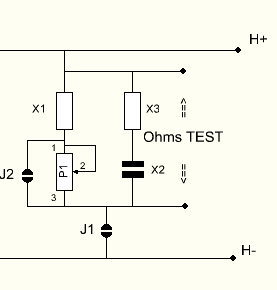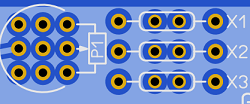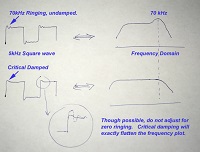Electron Engine ™
Printed Circuit Boards by Emissionlabs ®
EE20 Multi Purpose Board. Version 2.9
- Audio Board, Applications
 Audio Board, Tuning (You are here)
Audio Board, Tuning (You are here)
Tuning an Audio Transformer (this is not about Moving Coil)
First of all, tuning is not necessary for all transformers. If needed, this is written in the LUNDAHL data sheet, with recommended values. In you just want to proceed by the data sheet, the EE20 board is prepared for this, just add those parts, and it works.
It is not needed, having to understand TUNING before ordering or choosing a transformer. This page is for the interested user, who wants to get the upmost out of the transformers, and this can be done all in the end, when the transformers are working.
Input Impedance. For Audio Inputs, the impedance must only be within a certain range. Nobody would require an amplifier to have exactly 47k Ohms load, and say 20k would be wrong. Even so, too high input impedance is of no use, because it causes only hum sensitivity. Besides, a signal source which can drive 47k but not drive 20k, does not exist.
Much more important is to have no frequency roll off, or other errors. We do not want frequency loss over the audio range, which has a minimum requirement from 20...20kHz at 3dB. Most of all, we want no distortion.
Ideally, amplifier inputs are balanced. Unfortunately, this is almost never what they really are. But luckily... a tome transformer input is balanced by default :)
All tone transformers however have something called self resonance. This is caused by the inductance and capacitance of the transformer. The inductance is wanted, the capacitance is unwanted, but unavoidable. These form an LC resonator, and the useful frequency range of the transformer must be specified below it. More is written in the text below here.
This is just how all tone transformers behave, and as long as we operate within their specified range, the effect will not take place anyway. It is however relatively easy to extend their frequency range even above the resonance frequency. That is because at the resonance point, the impedance of the output signal goes up. Meaning already a resistive load is helpful. This will reduce the normal signal very little, but reduce the resonance a lot more. So with the right resistor the resonance will be eliminated. More precise functioning comes from a resistor-capacitor combination im series, and use this as extra load. This comes in with additional damping at higher frequency only. Finding such an RC combination is not even difficult, because what counts is the RC time. This means a fixed capacitor with a variable resistor can be adapted for optimized result. The outcome is the R and C value, which Lundahl recommends in the data sheet, for instance of LL1545, it is 6k7 with 470pF at 1:1. These values we add to the selection table. The EE20 board can attach this R and C as recommended by Lundahl, or even if you want, use a variable resistor for this network. Which last action needs of course an oscilloscope. Fixed values can be just soldered in, and need to further checking.
Self resonance
Having a self resonance point, is something which belongs to every transformer. By good design, this frequency can be pushed far out of the audible range, but at some point it will still occur. This is the cooking recipe of the transformer builder, and each has his own methods.
Self resonance means in a practical situation, the output signal will increase by itself when coming closer to this frequency. When this happens, however a phase error gets introduced. Even so, the amplitude does not go up just a little bit, but up to 50%. As long as a sine wave is within the specified frequency range for the product, self resonance will not take place. This is why some transformer manufacturers do not mention this information, simplifying the subject.
Measuring self resonance.
If we apply a square wave within the audible range, like 5kHz, this signal contains higher harmonics, some of which may be in the range of the self resonance frequency, and this causes the infamous ringing, even when the signal is the audio frequency. This means at every edge of the square wave, for a very short moment, the transformer resonates. Which means adding of new frequencies, which were not present in the original signal before. At the edge, we see an overshoot of 2...3 periods of the self resonance frequency. I find it difficult to say, if this is a "sound" problem or not. Is looks quite bad to see this in an oscilloscope. But it may become difficult to hear. Still when I hear people saying they can hear the sound of cables, or the better sound of gold plated connectors, I think it is 100x more useful to tune the transformer carefully.
Here is how it is recommended in the LL1544A data sheet.
![]()
The tuning network
 This network is universal, so depending on the use, MC or Audio Input, only some parts are used. Besides, feel free to use it your own way. It is drawn here with a capacitor at the position of X2, just to indicate the most likely use.
This network is universal, so depending on the use, MC or Audio Input, only some parts are used. Besides, feel free to use it your own way. It is drawn here with a capacitor at the position of X2, just to indicate the most likely use.
- P1 is a variable resistor of PCB type, which probably has not great audio quality. But it is only used for testing. Later it will be shorted by the Jumper J2 and electrically replaced by X1.
- X1, X3, and X3 can be a capacitor or a resistor.
- Jumper J1 has two functions. It switches the network on and off, to check the audible effect. Finally it is used to check with an ohms meter, at what value P1 is set.
- Do not try to measure this with Jumper J1 closed. This may damage the transformer, and besides the measured result is wrong anyway, because the output coil DC resistance is in parallel now.

This little part is all we need.

PCB potentiometers have different pin connections and dimensions. With this board lay out, most normal types will fit in.
For adjustment there are a few ways.
Example for LL1544a. (This is not a Moving Coil transformer)
- Use the data sheet. These are average values and in any case good. For LL1544A for instance, the data sheet specifies 470pF and 6k7 F for the RC network. Insert those values at X2 and X3, and activate the network by closing J1. Like this LL1544A is wired by the data sheet. So just as intended by Lundahl, nothing more and nothing less. The next part is about more precise adjustment, using an oscilloscope.
- Adjustment with an oscilloscope. I will replace the hand sketch by an oscilloscope pictures later.
 For an adjustable option, insert the capacitor of 470pF at the position of X1. at the board. The variable resistor will replace the 6k7 resistor and it's value should be 10k. J2 is open and J1 is closed. Now the network can be fine tuned for what is called critical overshoot, this is a quick and very reliable method to get the best adjustment.
For an adjustable option, insert the capacitor of 470pF at the position of X1. at the board. The variable resistor will replace the 6k7 resistor and it's value should be 10k. J2 is open and J1 is closed. Now the network can be fine tuned for what is called critical overshoot, this is a quick and very reliable method to get the best adjustment.
Example for LL1636. (This is a Moving Coil transformer)
So now everybody would like to send an email about the equipment he uses, and then we have to say the values of the R1, X1, X2, and X3. But this is not how it works. Please reset your expectation to the situation where you have only the Lundahl datasheet and the bare transformer in front of you. Then what would you do? The transformer data sheet can not say how much damping a specific cartridge needs. In the end you could try to calculate it perhaps, but the calculation is full of unknown parameters. So you would just try it out. It is exactly this which we encourage you do to, by using the preparations the EE20 board offers.
You need only a resistor at the secondary side. This resistor is transformed to the primary with the square root of the gain you choose. So as said it before: fist choose the gain, and then only after that, choose the damping resistor. The reverse order will give a mess.
When you have found the best sounding gain, sometimes there are two alternatives to get this gain: The "recommended way" and the "not recommended way". The last is not WRONG, because otherwise it would not be mentioned. Just TRY both alternatives, and if it sounds the same, take the recommended way. So this piano switch method gives here great advantage over a hand-wired application. Frankly, I would never de-solder everything from a hand-wired transformer just to try a not-recommended schedule. But is that the best way to go? Probably not! Besides how long can you really remember a sound impression?
So after you have found the best sounding connection scheme and gain, comes to choose the best sounding damping resistor. First enable the damping network by jumper J1. Then connect Jumper J2 also, and now X1 is connected to the transformer output. Solder two small pieces of wire in the X1 solder pads, and on those pieces, solder the resistors which you try out provisionally. Or a better even a potentiometer. First, find the resistor value low enough to cause a small, audible loss of high frequency. This value is not very critical. Remember this value! We use this resistor later at position X1, but not now. Then try a higher value, which is just on the limit, where it makes no difference any more. This value is going to be used for P1. Potentiometers have only specific values, so just take the next higher value. Like when you find 41k, round up the value, and take a 50k potentiometer for P1. So now we have already what we needed to know. We have X1 and we have a potentiometer value. OPEN J2 and insert the potentiometer, and the resistor in X1. Now with the potentiometer, we can vary between those two limits we found before.
* In case you intend to use the dual gain switch, do these measurements for the highest gain only. Then you can find a setting for P1 which works well on both gain settings.
The OHMS TEST option can be used when you are done with everything, and you may have no good feeling about a PCB potentiometer in the sound chain. For this, open J1. Only when J1 is open, the total resistance can be measured. Now take a resistor closest to this value, replace X1 by this resistor, and close both jumpers J1 and J2. Now the potentiometer is eliminated from the circuit, and can remain on the PCB for later experiments.
In short we can say, with too much damping, the sound becomes dull, and at to little damping the needles looses good contact with the groove. The ideal damping depends also on the weight of the head shell and stiffness of the tone arm. All of this can not be put in one number. So this is why we recommend variable damping, and switch it on and off, to hear for yourself if there is a difference. Do not regard this something "difficult" with Lundahl transformer, or the EE20 board. All MC cartridges have this requirement. This board just a convenient way to get a good result.
Note:
This was pointed out to me by my late Roger Modjeski: A MC cartridge is a coil, moving in a magnetic field. For that reason it is an electric generator. The output voltage depends on the CHANGE of the velocity per time unit. When the coil moves with the same velocity, there is no output signal. So what causes the velocity to change? Well with a frequency range of 20Hz, the velocity of the coil changes 40x from maximum to zero. With 20 kHz, the same is done 20.000 times in one second, so definitely a lot faster, as with 20 Hz. The change of velocity per second is 1000x higher at 20kHz, provided the amplitude is the same, and so the voltage goes up with the frequency. What causes damping? It occurs when the signal generates heat in a load. What causes this energy loss in a resistor is U^2 x R. But what causes the coil to generate this energy? It is Friction x path x time. (like power is Watt, and energy is kWh). From the view of the coil, we introduce the Friction with the load resistor. So when an object moves up and down a certain path path 20.000 times in one second, it looses 1000x more energy as when it makes the movement only 20 times. When you understand all of that, it should become clear why higher frequencies gets damped most, by an electric load. Though you would perhaps expect this to require an RC network, this is not so.